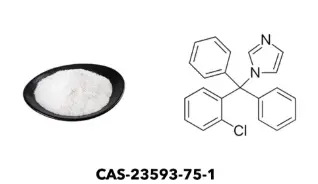Clotrimazole Powder is a popular antifungal medication used to treat various fungal infections of the skin. Many people who use this treatment often wonder about its efficacy and how quickly they can expect to see results. The time it takes for Clotrimazole powder to work can vary depending on several factors, including the type and severity of the infection, as well as how consistently the medication is applied. In this blog post, we'll explore the effectiveness of Clotrimazole powder and answer some common questions about its use.
What is Clotrimazole powder used for?
Clotrimazole powder is a versatile antifungal medication that is used to treat a wide range of fungal infections affecting the skin. Its primary use is to combat various types of tinea infections, which are caused by dermatophytes – a group of fungi that thrive on keratin, a protein found in skin, hair, and nails. Some of the most common conditions that Clotrimazole powder is used to treat include:

- Athlete's foot (tinea pedis): This is a fungal infection that typically affects the skin between the toes and on the soles of the feet. It can cause itching, burning, and scaling of the skin.
- Jock itch (tinea cruris): This infection occurs in the groin area and can spread to the inner thighs and buttocks. It's characterized by a red, itchy rash with a scaly border.
- Ringworm (tinea corporis): Despite its name, this condition is not caused by a worm but by a fungus. It appears as a circular, red, itchy patch on the skin that can occur anywhere on the body.
- Yeast infections: Clotrimazole can also be effective against certain yeast infections of the skin, such as those caused by Candida albicans.
The active ingredient in Clotrimazole powder works by interfering with the fungal cell membrane, causing it to become more permeable. This leads to the leakage of essential components from the fungal cells, ultimately resulting in their death. By eliminating the fungi responsible for the infection, Clotrimazole helps to alleviate symptoms and promote healing of the affected skin.
It's important to note that while Clotrimazole powder is effective against a variety of fungal infections, it's not suitable for treating all types of skin conditions. For example, it's not effective against bacterial infections or certain types of dermatitis. Therefore, it's crucial to get an accurate diagnosis from a healthcare professional before starting treatment with Clotrimazole powder or any other antifungal medication.
How do you apply Clotrimazole powder for best results?
To achieve the best results with Clotrimazole powder, it's essential to apply it correctly and consistently. Here are some guidelines to help you use Clotrimazole powder effectively:
- Clean and dry the affected area thoroughly before application. This helps to remove any debris or moisture that could interfere with the medication's effectiveness.
- Shake the powder container well before each use to ensure even distribution of the active ingredient.
- Apply a thin layer of the powder to the affected area and the surrounding skin. Use enough powder to cover the entire affected area, but avoid applying it too thickly.
- Gently rub the powder into the skin to ensure even coverage.
- Wash your hands thoroughly after applying the powder to prevent spreading the infection to other parts of your body or to others.
- Apply the powder as directed by your healthcare provider or according to the package instructions. Typically, this means applying the powder once or twice daily.
- Continue using the powder for the full duration of treatment, even if symptoms improve before then. This helps to ensure that the infection is completely eradicated.
- Keep the affected area clean and dry between applications. Moisture can promote fungal growth, so it's important to thoroughly dry the area after bathing or sweating.
- If you're treating athlete's foot, consider using the powder inside your shoes and socks to help prevent reinfection.
- Avoid sharing towels, clothing, or other personal items that come into contact with the infected area to prevent spreading the infection to others.
It's important to note that while Clotrimazole powder is generally safe for most people, some individuals may experience mild side effects such as skin irritation, redness, or itching. If you experience any severe reactions or if your symptoms worsen, discontinue use and consult your healthcare provider.
For optimal results, it's crucial to be patient and consistent with your treatment. Fungal infections can be persistent, and it may take several days or even weeks of regular application before you see significant improvement. If you don't notice any improvement after two weeks of treatment, or if your symptoms worsen, it's advisable to consult your healthcare provider for further evaluation and possible alternative treatments.
Can Clotrimazole powder be used for yeast infections?
Clotrimazole powder can indeed be effective for certain types of yeast infections, particularly those affecting the skin. Yeast infections are caused by an overgrowth of fungi belonging to the Candida genus, with Candida albicans being the most common culprit. While Clotrimazole is primarily known for its effectiveness against dermatophyte fungi (which cause conditions like athlete's foot and ringworm), it also has potent antifungal activity against many Candida species.
Here are some key points to consider regarding the use of Clotrimazole powder for yeast infections:
- Skin yeast infections: Clotrimazole powder can be highly effective for treating cutaneous candidiasis, which are yeast infections of the skin. These infections often occur in warm, moist areas of the body such as skin folds, under the breasts, in the groin area, or between fingers and toes. The powder form of Clotrimazole can be particularly beneficial in these cases as it helps to keep the affected area dry, which is crucial for controlling yeast growth.
- Diaper rash: Some cases of diaper rash are caused by yeast overgrowth. In these instances, Clotrimazole powder can be an effective treatment option. However, it's important to consult with a pediatrician before using any antifungal medication on infants.
- Intertrigo: This is a condition where rashes develop in skin folds due to friction, heat, and moisture. While not always caused by yeast, Candida can often complicate intertrigo. Clotrimazole powder can help treat the yeast component of this condition while also helping to keep the area dry.
- Vaginal yeast infections: It's important to note that while Clotrimazole is available in various forms for treating vaginal yeast infections (such as creams and suppositories), the powder form is not typically used for this purpose. For vaginal yeast infections, it's best to use the formulation specifically designed for vaginal use as recommended by a healthcare provider.
When using Clotrimazole powder for yeast infections, the application method is similar to that for other fungal infections. Clean and dry the affected area thoroughly, then apply a thin layer of powder to the infected skin and the surrounding area. For best results, apply the powder once or twice daily as directed by your healthcare provider or the product instructions.
While Clotrimazole powder can be effective for many cases of skin yeast infections, it's important to remember that not all skin rashes or irritations are caused by yeast. Some may be due to bacterial infections, allergic reactions, or other skin conditions that require different treatments. Therefore, if you're unsure about the cause of your skin condition, or if you've been using Clotrimazole powder without improvement, it's crucial to consult with a healthcare professional for an accurate diagnosis and appropriate treatment plan.
Moreover, for individuals with recurrent or severe yeast infections, Clotrimazole powder alone may not be sufficient. In these cases, oral antifungal medications or combination therapies might be necessary. Your healthcare provider can help determine the most appropriate treatment based on the specific nature and severity of your infection.
In conclusion, while Clotrimazole powder can be an effective treatment for certain types of yeast infections, particularly those affecting the skin, it's not a one-size-fits-all solution. Always consult with a healthcare professional for persistent or severe infections, and follow their guidance for the most appropriate treatment approach.
If you are also interested in this product and want to know more product details, or want to know about other related products, please feel free to contact sasha_slsbio@aliyun.com.
References
- National Health Service (NHS). (2021). Clotrimazole.
- MedlinePlus. (2021). Clotrimazole Topical.
- DermNet NZ. (2021). Topical antifungal medications.
- Centers for Disease Control and Prevention (CDC). (2020). Fungal Diseases.
- American Academy of Dermatology Association. (2021). Ringworm: Diagnosis and treatment.
- Mayo Clinic. (2021). Athlete's foot.
- Cleveland Clinic. (2020). Yeast Infections.
- The Journal of Clinical and Aesthetic Dermatology. (2016). Topical Antifungal Drugs for the Treatment of Onychomycosis: An Overview of Current Strategies for Monotherapy and Combination Therapy.
- British Medical Journal. (2018). Fungal skin infections.
- American Family Physician. (2001). Treatment of Common Cutaneous Fungal Infections.

